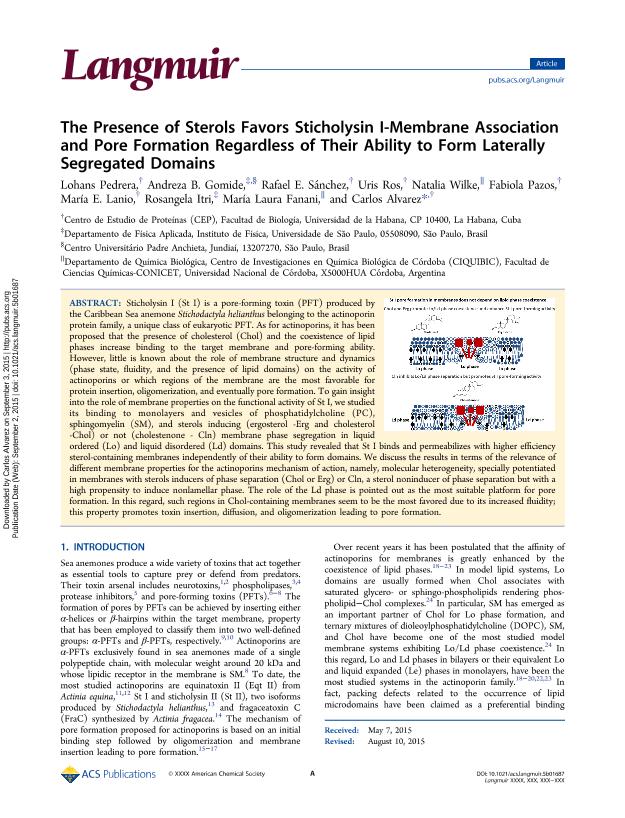Artículo
The presence of sterols favors Sticholysin I - membrane association and pore formation regardless of their ability to form laterally segregated domains
Pedrera Puentes, Lohans; Gomide, Andreza. B.; Sanchez, Rafael E.; Ros Quincoces, Uris; Wilke, Natalia ; Pazos, Fabiola; Lanio, María E.; Itri, Rosangela; Fanani, Maria Laura
; Pazos, Fabiola; Lanio, María E.; Itri, Rosangela; Fanani, Maria Laura ; Álvarez Valcárcel, Carlos Manuel
; Álvarez Valcárcel, Carlos Manuel
 ; Pazos, Fabiola; Lanio, María E.; Itri, Rosangela; Fanani, Maria Laura
; Pazos, Fabiola; Lanio, María E.; Itri, Rosangela; Fanani, Maria Laura ; Álvarez Valcárcel, Carlos Manuel
; Álvarez Valcárcel, Carlos Manuel
Fecha de publicación:
09/2015
Editorial:
American Chemical Society
Revista:
Langmuir
ISSN:
0743-7463
e-ISSN:
1520-5827
Idioma:
Inglés
Tipo de recurso:
Artículo publicado
Clasificación temática:
Resumen
Sticholysin I (St I) is a pore-forming toxin (PFT) produced by the Caribbean Sea anemone Stichodactyla helianthus belonging to the actinoporin protein family, a unique class of eukaryotic PFT. As for actinoporins, it has been proposed that the presence of cholesterol (Chol) and the coexistence of lipid phases increase binding to the target membrane and pore-forming ability. However, little is known about the role of membrane structure and dynamics (phase state, fluidity, and the presence of lipid domains) on the activity of actinoporins or which regions of the membrane are the most favorable for protein insertion, oligomerization, and eventually pore formation. To gain insight into the role of membrane properties on the functional activity of St I, we studied its binding to monolayers and vesicles of phosphatidylcholine (PC), sphingomyelin (SM), and sterols inducing (ergosterol -Erg and cholesterol -Chol) or not (cholestenone - Cln) membrane phase segregation in liquid ordered (Lo) and liquid disordered (Ld) domains. This study revealed that St I binds and permeabilizes with higher efficiency sterol-containing membranes independently of their ability to form domains. We discuss the results in terms of the relevance of different membrane properties for the actinoporins mechanism of action, namely, molecular heterogeneity, specially potentiated in membranes with sterols inducers of phase separation (Chol or Erg) or Cln, a sterol noninducer of phase separation but with a high propensity to induce nonlamellar phase. The role of the Ld phase is pointed out as the most suitable platform for pore formation. In this regard, such regions in Chol-containing membranes seem to be the most favored due to its increased fluidity; this property promotes toxin insertion, diffusion, and oligomerization leading to pore formation.
Archivos asociados
Licencia
Identificadores
Colecciones
Articulos(CIQUIBIC)
Articulos de CENTRO DE INVEST.EN QCA.BIOL.DE CORDOBA (P)
Articulos de CENTRO DE INVEST.EN QCA.BIOL.DE CORDOBA (P)
Citación
Pedrera Puentes, Lohans; Gomide, Andreza. B.; Sanchez, Rafael E.; Ros Quincoces, Uris; Wilke, Natalia; et al.; The presence of sterols favors Sticholysin I - membrane association and pore formation regardless of their ability to form laterally segregated domains; American Chemical Society; Langmuir; 31; 36; 9-2015; 9911-9923
Compartir
Altmétricas



